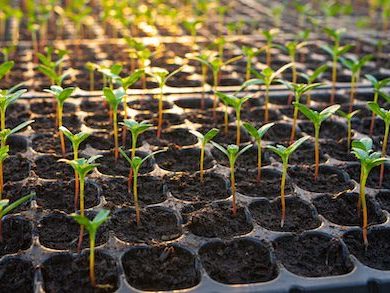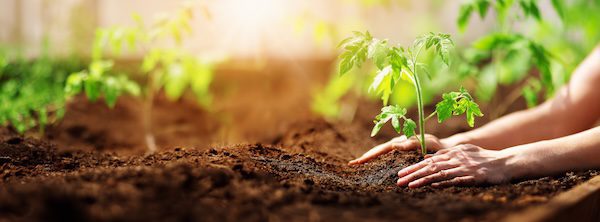You’ve started your seeds on time and taken impeccable care of the seedlings in the greenhouse. They’re growing like crazy, it’s a gorgeous spring day with warm sun and a gentle breeze, and you’re wondering if today might be the day to put those babies in the ground. But wait! Before you go any further, read this first.

A common mistake many beginning gardeners make is starting hardening seedlings off too early or skipping the process altogether, subjecting baby plants to transplant shock and temperature stress. If one or the other (or both) doesn’t kill your seedlings, it will likely stunt their growth for the rest of the season.
What is hardening off?
At its simplest, hardening off simply means acclimating indoor-grown seedlings to outdoor conditions. It’s a misconception that hardening off only refers to getting seedlings used to outdoor temperatures. While temperature does play a major role in seedling development, exposure to sunlight, wind, humidity, and pests is just as important a factor in plant growth.
Advanced gardeners and beginner growers alike can fall into some bad habits and common hardening off mistakes. Here are some tips for what to do instead, for a seamless transition from seedlings to a healthy, thriving garden.
5 Common Mistakes to Avoid When Hardening Off Seedlings
As with most anything else, hardening off seedlings can fail when you end up doin’ too much. Gradual and moderation are the keys to success when transitioning indoor-grown seedlings to the outdoors.
Here are five common mistakes gardeners make when it comes to hardening off seedlings:
One: Starting too early
It’s only human nature to get excited about warmer weather and want a headstart on your summer garden. But here’s the thing about weather: it’s always subject to change, especially in the shoulder seasons of spring and fall. Even though waiting can feel torturous, it’s far better to hold off planting cold-sensitive seedlings until after all risk of frost is past.

It might seem like getting a headstart on your spring planting will mean you’ll have the earliest tomatoes, but actually, the opposite is true. Planting too early, when temps still hover around freezing most nights, will stress unprepared seedlings and stunt their growth, pushing your first harvest back further than if you’d just waited an additional week or so. But the other side of the timing coin – waiting too late – can be problematic, too. Leave seedlings indoors too long and they might become rootbound, which could stress the seedling out to the point of bolting, or flowering early.
With hardening off, it’s really a Goldilocks situation – look for the weather window that’s “just right” and don’t sleep on it!
Two: Moving too fast
People often assume that hardening off is a simple process that happens over a day or two, but that couldn’t be further from the truth – hardening off is a gradual process that, ideally, should take at least a week or more.
The idea behind hardening off is to gradually introduce seedlings to outdoor conditions, and it doesn’t happen overnight – seriously. We’ll go over a sample hardening off schedule later.
If you don’t take the full time that hardening off takes, you risk seriously damaging seedlings in a very important stage of development, to the point that the seedlings may not be able to recover and may not be as productive as they could be.
Waiting is one of the harder things to do, but a slower pace is essential to successfully harden off indoor-grown seedlings to outdoor conditions.
Three: Too much direct sunlight
It might come as a surprise (and then again it may not), but sunlight is significantly more intense than artificial light, so it’s not the healthiest thing for indoor seedlings straight out of the gate. Why?
Plants have a waxy membrane called a cuticle. Frontiers in Plant Science published an article about the function of the cuticle, which is primarily to protect the plant from the outside environment. Greenhouse-grown seedlings have a weaker cuticle since there’s a protective layer of plastic in between the plant and the sun.
An article published by the Illinois Extension Office explains the connection between hardening off and plant cuticles: the process of hardening off strengthens the cuticle by encouraging it to thicken, so it’s better able to stand up to the sun’s harsh rays.
As intoxicating as a sunny spring day is, it’s actually easier on seedlings to spend their first hours outside on an overcast – even rainy – day. Seedlings can stand to be outside longer if they are protected by partial shade or cloud cover, but if you do need to put your seedlings out for the first time in bright sunlight, just keep the sessions short.
Four: Giving seedlings too much water
In a greenhouse, you’re very likely watering seedlings daily, if not twice a day. Part of the point of hardening off is to get seedlings used to drier soil and less humid conditions, so slack off on watering once you start setting seedlings outside.
Overwatering encourages shallow roots, and seedlings need sturdy root systems to survive transplanting. Show your seedlings some tough love by withholding water, and they’ll be stronger for it. Don’t let the plants dry out to the point of damage, but allow the soil to dry out completely between waterings.
Five: Not knowing if plants are hardy
Possibly the mistake with the biggest consequence – but also the most preventable – know if the seedlings in question are hardy or not! Hardy plants can tolerate a moderate freeze, but even a light frost will kill cold-sensitive plants.
Make sure that nighttime temperatures will at least be in the mid-40s for hardy crops and in the mid 50s for heat-loving plants. Know the baseline temperatures specific seedlings can tolerate, and only start the hardening off process once the projected lows are safe.
Hardening off is not a sit-and-forget process! Check on your seedlings throughout the day, and definitely keep an eye on the weather forecast so that you can provide some extra protection if needed or move the seedlings back inside early if temperatures drop unexpectedly.
How to know when seedlings are ready for hardening off
You’re nearing your last frost date

Last year the USDA updated its USDA Plant Hardiness Zone Map and put a lot of gardeners in a slightly warmer half-zone. But that doesn’t necessarily mean that you can plant seedlings any earlier.
It’s far better to go off on average last frost dates than the USDA map when planning when to start hardening off seedlings. Head on over to our frost chart to find the average first and last frost dates in your area.
As a rule, cold-sensitive plants can be hardened off a week or two before the last frost date. Frost-tolerant plants can start hardening off two weeks to a month before the last frost date, and be planted prior to the last frost.
Seedlings develop “true leaves”
The first tale-tell sign that seedlings are ready to start hardening off is when the seedlings grow true leaves. Technically the second set of leaves to grow on seedlings after cotyledons (the embryonic leaf), true leaves resemble the plants’ adult foliage, and they are the first leaves with the capability to perform photosynthesis (cotyledons feed on stored energy from the seed).

Wait until the seedlings have three to four sets of true leaves before transitioning them outside. They will be several inches tall and have developed sturdy root systems.
Cotyledons start yellowing
Though not enough of an indicator on its own to move plants outside, yellowing cotyledons can be a clue that seedlings are moving into the next stage of development.
If the weather isn’t right or the seedings are still too small to go outside, don’t worry too much. Cotelydons will naturally fall off as the seedling grows, and it’s no big deal. If the seedlings’ true leaves begin to yellow, that is more cause for more concern, an easily remedied once you find out the root cause of the discoloration.
Hardening off seedings the right way: a sample schedule
Finding the right location to harden off seedlings really helps boost success. Look for a sheltered location (like against a building or wall) and elevate the seedling trays or pots on a table or bench (this helps keep slugs off of your plants).

Use a shade cloth or patio umbrella to protect seedlings from direct sun during the hottest part of the day, and you can even drape frost cloth over seedlings that are particularly appealing to birds and insects. Cold frames and cloches are useful tools to place around seedlings at night, creating a slightly warmer microclimate.
Check the weather forecast before you start the hardening off process, and aim to begin on an overcast day. A good rule of thumb is to increase the time a plant spends outside by one or two hours each day, working up to overnight exposure. If you have the luxury of time or nighttime temps aren’t quite warm enough, spend twice as many days in each phase and transplant on Day 14.
Days 1 & 2:
Set seedlings outside in a sheltered area that receives indirect sunlight. Leave the plants outside for a few hours of morning sunlight, but bring them in before noon.
Days 3 & 4:
Set seedlings outside midmorning in a less protected area so they are exposed to a gentle breeze. Leave the plants outside until early afternoon to build up their tolerance to direct sunlight.
Days 5 & 6:
Set seedlings outside in the early morning and leave the seedlings out all day and overnight – they’ll be just fine!
Day 7:
Weather permitting, it’s time to plant those properly hardened off seedlings! If possible, plan to transplant on an overcast day with rain in the forecast, and cover the transplants with frost cloth or cloches for extra protection, though not required.
In summary
Hardening off is a week-long process that involves gradually introducing indoor-grown seedlings to outside conditions, including more direct sunlight, cooler temperatures, and less humidity.
Hardening should take at least a week and up to two, depending on your area’s last frost date and the species-specific needs of the plants. Start with a couple of hours on an overcast day and gradually work your way up to a full day in the sun. Once the seedlings have spent a night or two outside, they are ready to plant!